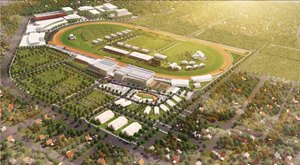Pimlico Study Hasn't Changed Stronach Group's Stance


With grand plans, bright architectural renderings, and numbers to back it all up, the study on Pimlico Race Course published Dec. 13 by the Maryland Stadium Authority may have given those wishing to keep the Preakness Stakes (G1) in Baltimore a glimmer of hope.
But from the perspective of Pimlico's owner, The Stronach Group, not much has changed.
From that view, the Preakness can stay at Pimlico, as long as The Stronach Group doesn't have to pay for the track to be rebuilt. And Tim Ritvo, the organization's chief operating officer, has been consistent in his belief that the second leg of the Triple Crown would be better suited at Laurel Park, about 28 miles south of Pimlico.
The report suggested it would cost $424 million to tear down completely and rebuild Pimlico as a multi-use facility, but what was missing from the report is any specifics on how the project would be funded. What's been made clear is that it won't be funded—at all—by The Stronach Group.
BALAN: Maryland Stadium Authority Calls for Rebuilt Pimlico
"It doesn't get paid for by us," Ritvo said Dec. 20. "The reason is, we have an alternative. At Laurel, (the Preakness) will work as good or better. … And there's been no indication yet (on where the funding might come from). Everybody is trying to figure out how to make the economics work. We're listening still. There's meetings going on all the time, but we haven't even heard if the state is willing to participate with funding."
Ritvo has not wavered from his support in recent years for a single major Thoroughbred racetrack in Maryland. With that, the Preakness would have to move to Laurel.
BALAN: Ritvo: Preakness Could Become Elite Event at Laurel
"There's a lot of reasons it works better at Laurel, and the history and the culture is a tough thing to get over. But the bottom line is, from a business perspective, one super track is better than two tracks," Ritvo said. "From a horseman's perspective, I cannot see why the horsemen wouldn't be 100% supportive of one facility. When the Preakness is run, people come into that event from all around the country, they look around, and they leave. And they never call a trainer again from Laurel.
"But when they come to Laurel and actually see what's been done and how great it would be, it would grow the industry."
But if a brand-new Pimlico facility would be fully paid by an entity or entities that aren't The Stronach Group, Ritvo said it would be "foolish" for the organization not to consider keeping the Preakness in Baltimore.
"Every big city has their problems. Baltimore seems to have a few extra problems—they need schools, they need police, they need infrastructure," Ritvo said. "I hate it, because it always looks, from (a certain) angle, like we're just trying to move. We actually believe it's in the best interest of racing to have one super track, but we've always been open.
"We participated in the study at great expense to see what they have to offer. I actually think it's better served, for the state of Maryland, to be at Laurel. But if you're going to build us a $400 million-$500 million stadium, we have to look at that."
Regardless of what happens to Pimlico, added stabling will be required in the state, and The Stronach Group intends to revamp Bowie Race Track as a training track. Bowie was closed as a racing facility in the 1980s and as a training facility in 2015. The Bowie plan is needed to house and train horses, because the horses currently housed at Pimlico would be displaced if the track ceased operations. Also, the Maryland Stadium Authority proposal for a rebuilt Pimlico does not include a full stable area. Laurel also doesn't have sufficient space to take in the extra horses.
Ritvo is hopeful funds from the Racetrack Facility Renewal Account in Maryland can be used to renovate Bowie. Currently, Maryland law allows RFRA funds, which are generated from video lottery facilities, to be spent on racetracks (Laurel, Pimlico, and Timonium, and Standardbred tracks Rosecroft Raceway and Ocean Downs Race Course) but not on training centers.
With The Stronach Group unmoved from its stance regarding Pimlico, however, the proverbial ball is in the court of the City of Baltimore and the State of Maryland, and the value of keeping the Run for the Black-Eyed Susans in Charm City will have to be weighed against a massive price tag.
"We're conscious of the (impact the Preakness has on Baltimore)," Ritvo said. "Me not being a Baltimorean, I'll never understand it, because there's definitely a better purpose for that area than putting a racetrack there. The racetrack has been there for 140 years, and it hasn't helped that community."
